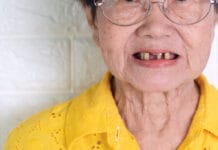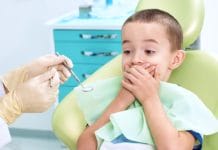Are you in need of CE credits? If so, check out our peer-reviewed, self-study CE courses here.
Test Your Dental Hygiene History Knowledge
1. What year did Irene Newman first perform the duties of a dental hygienist?
In 1890, the same year Dr. Alfred Fones graduated from dental school, the understanding that bacteria caused dental decay was emerging. At the time, dentists were trying several approaches to combat bacteria. One such approach was "Odontocure," where "a woman with an orange wooden stick, pumice, and a flannel rag patrolled the neighborhood cleaning teeth."1 However, dentists were so busy extracting teeth that many gave up trying to provide preventive treatment. Dr. Fones had an idea for a different approach.1
Dr. Fones trained his dental assistant (also his cousin) to provide preventive treatment. Irene Newman first performed the duties of what Dr. Fones called a dental hygienist in 1907. Much of the public scoffed at the idea of visiting the dentist regularly for preventive care, but some did support it.1
Reference
1. Lehman, E. (n.d.). Alfred Fones, Irene Newman, and the Dental Hygiene Revolution. Bridgeport Library: Bridgeport History Center. https://bportlibrary.org/hc/education/dr-alfred-fones/
2. Where was the first dental hygiene program established?
In 1913, Dr. Alfred Fones and Irene Newman began instructing the first class of dental hygienists. People came from as far as Japan to attend this program at their carriage house basement clinic in Bridgeport, Connecticut.1
On June 5, 1914, twenty-seven of the thirty-three women who began the inaugural course – including school teachers, nurses, and dental assistants – graduated as dental hygienists. Later that year, ten graduates started working in the Bridgeport, Connecticut, public schools as part of a pioneering, five-year demonstration project to provide educational and preventive dental services to children.2
The success of this initiative led to more hygienists being hired by the Bridgeport schools and prompted the establishment of two more training courses in 1915 and 1916. After the third and final course in 1916, organized institutions took over the training of dental hygienists. The three Fones courses graduated a total of ninety-seven hygienists. The role of dental hygienists soon expanded beyond schools and private practices to include hospitals and industrial clinics, such as the one at the Yale & Towne Lock Company.2
References
1. Lehman, E. (n.d.). Alfred Fones, Irene Newman, and the Dental Hygiene Revolution. Bridgeport Library: Bridgeport History Center. https://bportlibrary.org/hc/education/dr-alfred-fones/
2. Fones, A.C. The Origin and History of the Dental Hygienists [Read before the Section on Mouth Hygiene, Preventive Dentistry and Public Health at the 7th International Dental Congress, Philadelphia, PA, August 24, 1926]. Journal of Dental Hygiene. 2013; 87(Suppl 1): 58-62. https://jdh.adha.org/content/jdenthyg/87/suppl_1/58.full.pdf
3. The American Dental Hygienists’ Association was established in 1923. Winifred “Dorothy” Hart was elected as the first president.
Following the founding of the first dental hygiene program by Dr. Fones, more educational programs emerged, and several states began regulating dental hygiene. Local and state hygienist societies started to form in many of these states. The dental hygienists of California played a large role in bringing the idea of organizing a national dental hygienists' association to the attention of American Dental Association (ADA) officials at a meeting in Los Angeles, California, in July 1922.1
With the approval of the ADA, 46 dental hygienists from different states convened at the Hollenden Hotel in downtown Cleveland, Ohio, on September 12, 1923, for the first Annual Conference, officially establishing the American Dental Hygienists' Association (ADHA). These hygienists drafted the first constitution and bylaws, allowing officers to be elected to unify and lead the new organization. Winifred "Dorothy" Hart of Bridgeport, Connecticut, was elected as the ADHA's first president.1,2
References
1. Fones, A.C. The Origin and History of the Dental Hygienists [Read before the Section on Mouth Hygiene, Preventive Dentistry and Public Health at the 7th International Dental Congress, Philadelphia, PA, August 24, 1926]. Journal of Dental Hygiene. 2013; 87(Suppl 1): 58-62. https://jdh.adha.org/content/jdenthyg/87/suppl_1/58.full.pdf
2. 100 Years of Leadership in Oral Health. (2023). American Dental Hygienists' Association. https://www.adha.org/events/adha-celebrates-100/
4. The ADHA adopted the term "registered dental hygienist" as the official credential of the profession in 1925.
Before Dr. Fones used the term "dental hygienist," the individuals who performed dental prophylactic treatments were called other names, such as "odontocure" and "dental nurse." However, Dr. Fones felt these terms were misleading, as they focused on treating disease rather than prevention. He believed that the name "dental hygienist" more accurately conveyed the profession's focus on maintaining health, leading him to adopt the term in 1911. This new name emphasized the preventive and educational aspects of the role.1
The ADHA officially adopted the term "registered dental hygienist" as the profession's official credential in 1949.2
References
1. Fones, A.C. The Origin and History of the Dental Hygienists [Read before the Section on Mouth Hygiene, Preventive Dentistry and Public Health at the 7th International Dental Congress, Philadelphia, PA, August 24, 1926]. Journal of Dental Hygiene. 2013; 87(Suppl 1): 58-62. https://jdh.adha.org/content/jdenthyg/87/suppl_1/58.full.pdf
2. 100 Years of Dental Hygiene. (2013). American Dental Hygienists' Association. https://www.tiki-toki.com/timeline/entry/55646/100-Years-of-Dental-Hygiene
5. Which occurred in the same decade that the first edition of Clinical Practice of the Dental Hygienist by Dr. Esther Wilkins was published?
During an internship at the Eastman Dental Dispensary in Rochester, New York, the University of Washington in Seattle recruited Dr. Esther Wilkins to establish and build a dental hygiene program at the new dental school from the ground up in 1950.1-3
From ordering instruments, recruiting clinical faculty, and creating a curriculum, she started from scratch. However, the dental hygiene textbooks at the time were out of date and less than comprehensive. To supplement her teaching, Dr. Wilkins created her own text on specialized dental hygiene subjects, distributing her lessons to students as handouts that they collected in loose-leaf binders.2
During the same decade, the standards for dental hygiene education were set by the ADA Council on Dental Education in 1951. The following year, in 1952, the accreditation of dental hygiene programs began. In 1957, the first standalone ultrasonic scaler was introduced.4
In 1959, making his usual rounds, a textbook salesperson spotted the thick stack of lessons piled on Dr. Wilkins' desk. He asked to take a look and said it should be published.2 That fall, the first edition of Clinical Practice of the Dental Hygienist was published.2,4
References
1. Columns Staff. (2017, February 28). Esther M. Wilkins (1916-2016). University of Washington Magazine. https://magazine.washington.edu/esther-m-wilkins-1916-2016/
2. Flaherty, J. (2012, March 13). By the Book. Tufts University. https://now.tufts.edu/2012/03/13/book
3. Shoreline CC Is School's New Dental Hygiene Training Partner. (2020, September 28). University of Washington School of Dentistry. https://dental.washington.edu/shoreline-cc-is-schools-new-dental-hygiene-training-partner/
4. 100 Years of Dental Hygiene. (2013). American Dental Hygienists' Association. https://www.tiki-toki.com/timeline/entry/55646/100-Years-of-Dental-Hygiene












